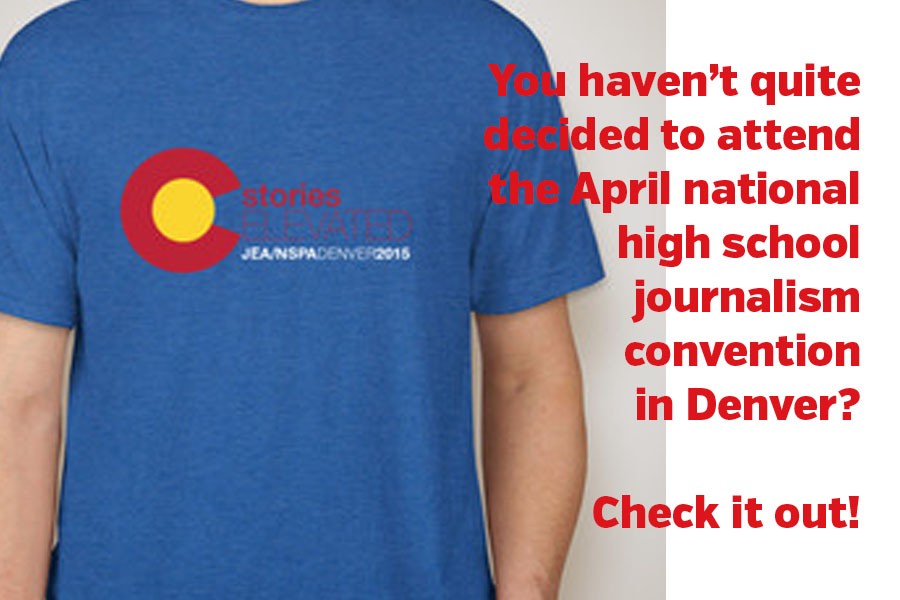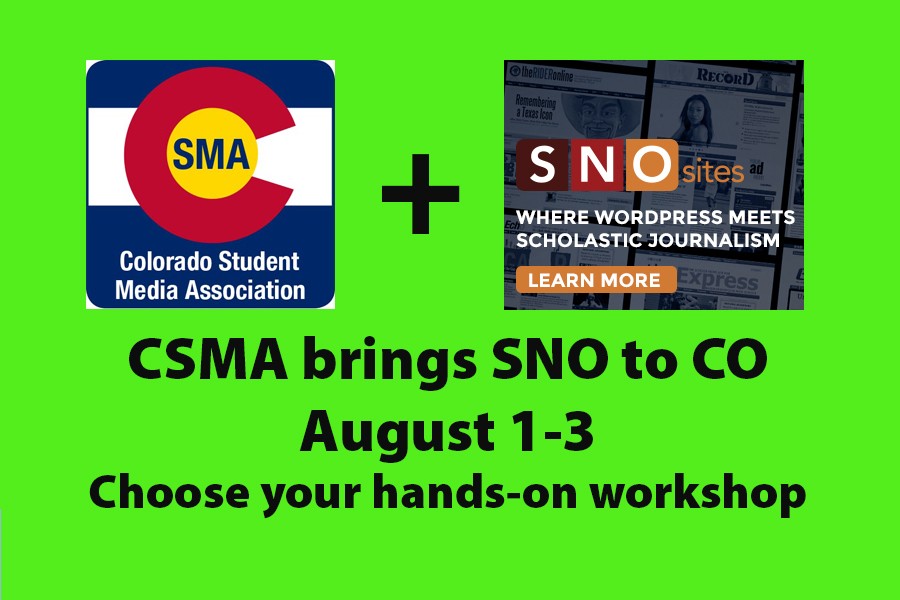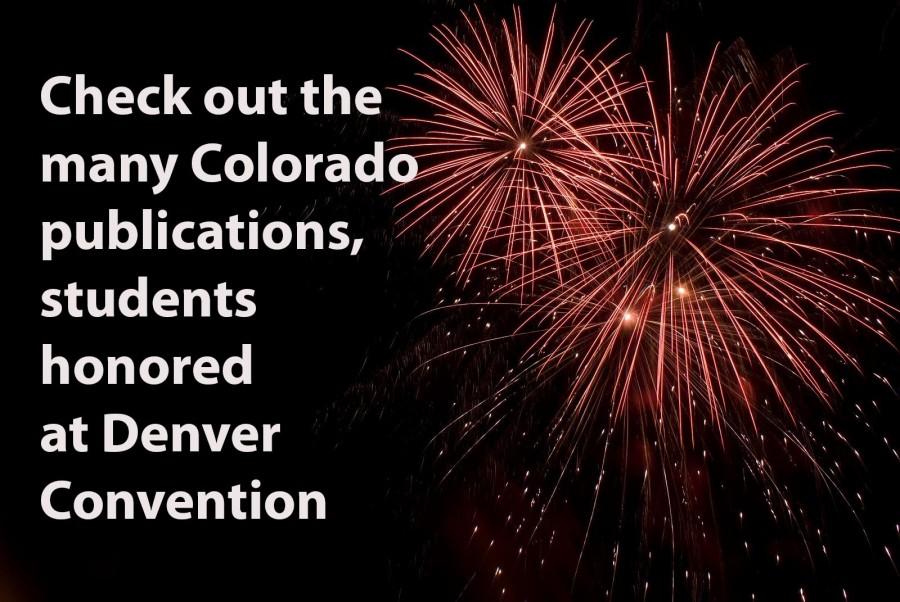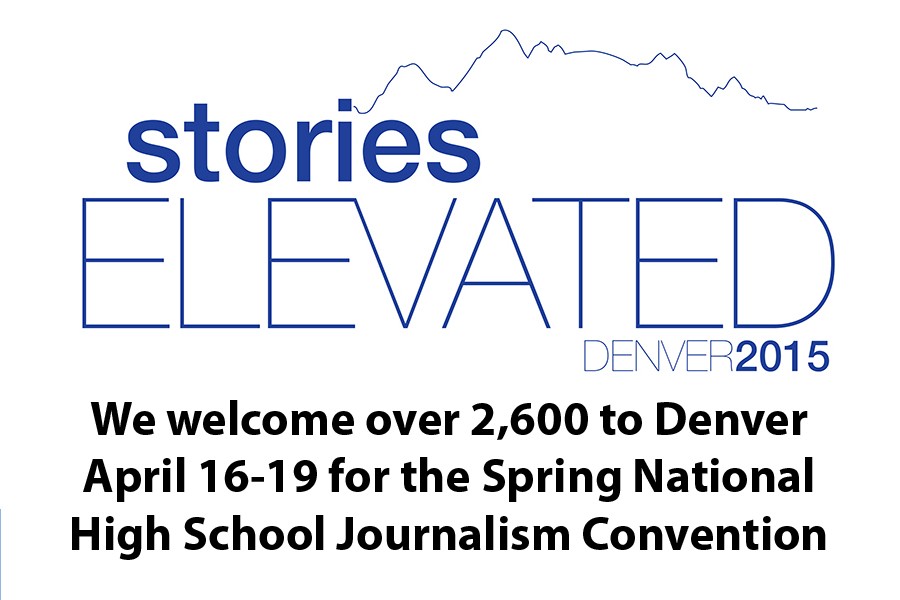If you are on the JEA Listserv, you may have seen some of the post below. If not, perhaps these “teasers” are just what you need to find the time and energy to organize a great trip to downtown Denver, April 16-19, for the Spring National High School Journalism Convention. CHSPA is the local hosting organization, and a local committee of nearly 40 have been working for over a year to pull together the best in speakers, workshops, media tours, cultural opportunities, and more.
Having the convention come to us is a once-in-a-decade chance to connect with thousands of media students and their advisers, at a very reasonable cost.
Come for the culture
Visitors are sometimes surprised by the breadth of theater, music and arts offerings in Denver. Check out this piece from the Denver Post.
The Denver Center for the Performing Arts is worth a look while you are in Denver. A behind-the-scenes media tour is offered to you on Thursday of the convention. And there are some interesting choices for you and your students if you have a couple hours for top-notch live theater.
The 12-acre, 11 theater complex is a 7 block walk from the Sheraton, a 3 block walk from the Curtis Street free mall ride shuttle stop, and 1 block from the Theatre District light rail station, so it couldn’t be more convenient.
Book tickets at http://www.denvercenter.org/shows
One Night in Miami… Mar 20 – Apr 19, 2015 The Space Theatre
Slice-of-life dramedy that imagines what occurred the night Cassius Clay spent with activist Malcolm X, singer Sam Cooke and football player Jim Brown after Clay’s historic win over heavyweight champ Sonny Liston in 1964.
The 12 Mar 27 – Apr 26, 2015 The Stage Theatre
This brand new rock musical follows the twelve apostles as they wrestle with fear, uncertainty, anger and love in the days following their Teacher’s death. Picks up where “Jesus Christ Superstar” leaves off.
Motown the Musical Mar 31 – Apr 19, 2015 The Buell Theatre
The smash musical tells the true story of Motown founder Berry Gordy’s journey from featherweight boxer to heavyweight music mogul. His American dream launched the careers of Diana Ross, Michael Jackson, Smokey Robinson, shattered barriers, shaped our lives and made us move to the same beat.
From Peter Yarrow at the Oriental on April 17, to Snoop Dog at the Denver Mart on April 18, there is a wide range of live music for you in the downtown area. Check out options at http://thrillcall.com/live-music/denver
Westword, a weekly magazine that is hyper-local, has an extensive listing of cultural opportunities on its website. The museum district is just a couple blocks south of the Sheraton, and offers something for everyone. You won’t want to miss the new “1968” exhibit at the History Colorado museum. See what life was like when your local chair was graduating from high school (and then come ask me about all the details).
Find everything you need to know about registration, hotel, student registration scholarships, and much more at http://denver.journalismconvention.org/
Come for the Denver experience
You won’t run out of options for how to spend some time after sessions in Denver.
The trivia contest is back Friday night, as well as the always fun Swap Shops.
If you want to get out of the hotel, consider checking out one of the fastest sports around: indoor lacrosse, with the Colorado Mammoth hosting the Rochester Knighthawks. Tix start at $10. Check out details here.
Saturday night will feature some poetry slam action, led by the poet laureate of Aurora: Jovan Mays.
A selection of movie theaters and live theater is in easy walking distance, and there are hundreds of interesting restaurants within a mile of the hotel, from fine dining to fast food.
Come for the journalism education
Denver convention speakers have been encouraged to includes excerpts from “Other Than Honorable,” the Pulitzer-winning series, written by Dave Philipps, but involving a large team of Colorado Springs Gazette journalists. The photojournalism, website design, information graphics, editing decisions… all are rich in possibilities for our classrooms.
We are honored to have Philipps, along with photographer Michael Ciaglo and editor Joanna Bean, join us for our Thursday night keynote on April 16. The experience will be much more compelling if you and your students are familiar with this series.
Go to http://denver.journalismconvention.org/one-story/ to find not only more background on the ONE STORY concept, but a direct link to the four-part series. You will also find ten specially developed lesson plans that can be used directly or adapted for your own classroom. Kudos to JEA’s talented Curriculum Initiative Team for their work here.
Sometimes the hardest thing to do when confronted with a many-thousand word story is to just get going. At the risk of overwhelming you with this extraordinarily long email, here is the extended lede to the series, with comments from me interspersed. We used to call this “interrupted reading” in AP Lang Land (Roy Peter Clark might call it X-ray Reading), but this is the sort of exercise that makes for a worthy 15-minute segment of any media class.
The story begins…
Kash Alvaro stared at the ceiling of an emergency room in January listening to the beep of an EKG monitor for what he guessed was the 80th time in 12 months. The once-healthy Afghanistan War veteran had collapsed in a hallway that night, then awakened confused in an ambulance and lurched up in alarm, swinging and yelling until the paramedics held him down and injected sedatives. Now he lay alone in a room at Memorial Hospital, quietly weeping.
We jump right into the story (this would be a great first shot in a TV movie) with a descriptive lede that embraces the complex sentence before finishing with a short, compelling sentence. That 35-word second sentence doesn’t bog us down, but instead takes us through what happened that night chronologically, like a “movie in print.” Note how the verbs go from “swinging” and “yelling” to “weeping.” That progression is devastating.
Alvaro joined the Army at age 18 in 2008. In Afghanistan in 2009, he was hit by multiple bomb blasts, including one that threw him across a road like a lawn dart. Sophisticated armor helped him escape with just bruises, but the blasts battered his brain. Ever since, he has been hit with heart spasms and seizures.
At this point, readers need some background on who Kash Alvaro is, but the background chosen is focused on what put him in this position, not on some broader biographical facts. This will be a long piece of reporting, but the writer and editors still must struggle as much with what to leave out as with what to include. We also get our first simile in this graf – “like a lawn dart” – an image that combines danger and play, and that lingers in the mind.
Alvaro is in many ways the typical modern disabled veteran. He survived combat with barely a scratch but later was diagnosed with what have become the most common wounds of a decade of war — traumatic brain injury and post-traumatic stress disorder, which together likely affect more than half a million veterans of Iraq and Afghanistan, the Department of Defense said.
What happened when he came home is increasingly typical, too. At Fort Carson, the damaged soldier racked up punishments for being late to formation, missing appointments, getting in an argument and not showing up for work. These behaviors can be symptoms of TBI and PTSD, and Army doctors recommended Alvaro go to a special battalion for wounded warriors. Instead, his battalion put him in jail, then threw him out of the Army with an other-than honorable discharge that stripped him of veterans benefits. He was sent packing without even the medicine to stop his convulsions.
An important conflict is established here, between medical recommendations and military priorities, but the two are not treated as equal. The word “even” in the final sentence establishes the writer’s view that something more could have been done. A clear sense of justice underlies this entire series, and it is important to convey that early to readers.
“It was like my best friend betrayed me,” Alvaro said at the hospital, his speech as slow as cold oil. “I had given the Army everything, and they took everything away.”
The first direct quotation in the story comes “just in time,” and provides an emotional punch. Not only does Alvaro use an emotional simile in his quote (“it was like my best friend betrayed me”), but the writer chooses a simile to describe Alvaro’s speech that is as unusual as it is arresting. Readers actually need to slow down to fully grasp “as slow as cold oil.” Go ahead: try to say it fast out loud.
After the longest period of war in American history, more soldiers are being discharged for misconduct than at any time in recent history, and soldiers with the most combat exposure are the hardest hit. A Gazette investigation based on data obtained through the Freedom of Information Act shows the annual number of misconduct discharges is up more than 25 percent Army-wide since 2009, mirroring the rise in wounded. At the eight Army posts that house most of the service’s combat units, including Fort Carson in Colorado Springs, misconduct discharges have surged 67 percent. All told, more than 76,000 soldiers have been kicked out of the Army since 2006. They end up in cities large and small across the country, in hospitals and homeless shelters, abandoned trailers and ratty apartments, working in gas fields and at the McDonald’s counter. The Army does not track how many, like Alvaro, were kicked out with combat wounds.
At this point readers get what is often called the “nut graf,” or the wider point that prompted the writer to report on one man who helps represent an issue. The classic Ernie Pyle line – “If you want to tell the story of a war, tell the story of one solder” – comes to mind here. There’s a lot jammed into this graf, and there will be more research, more statistics, to come. We learn that this was not an easy story to report (FOIA was involved), that there is a trend here, and that the numbers are significant.
I hope you will agree that once readers get started on this series, they will want more. I hope you will want more. And Denver is the place to come to have a great conversation about this great series.
Come to explore
A fun walking excursion from the hotel takes you four blocks to the historic state capitol for a quick tour, on your own or guided.
Now that you are in the Capitol Hill area, you need a snack, so why not stop by Liks Ice Cream, locally owned (in fact, one of our local committee members is an owner)? Read about their delicious offerings at http://www.liksicecream.com/ and it never hurts to ask for the JEA discount!
Refreshed, you can walk two more blocks to the Molly Brown House (as in “Unsinkable”), which is a 45-minute tour with lots of unique photographs and little-known history of Denver and Molly herself. Read all about it at http://www.mollybrown.org/
It’s going to be sunny and 65 degrees (well, that’s the historical average high for mid-April), so why not continue your walk by heading east on Colfax (the country’s longest continuous street) to the only Voodoo Doughnuts shop outside Oregon? There’s likely to be a line, of course, but it’s worth it. Get details here.
Ready for more? At this point you are just a few blocks from either the Denver Zoo or the Denver Botanical Gardens. Whew!
Just get here!
Getting to Denver International Airport is easy, with hundreds of flights to choose from. The airport itself is 23 miles from the Denver Sheraton, and the light rail will not be ready for our convention (shockingly, there were construction delays and it won’t open until early 2016).
Have a small group to get from DIA to the convention hotel? Taxis are plentiful and the one-way cost is $55. You can find phone numbers for all the taxi companies serving the airport here.
SuperShuttle is offering a round trip fare of $38 per person, round trip tix only. You can book online here with the offer code NJHSC.
Everyone is capable of finding other options on the Web, including car rentals (particularly helpful if you are interested in spending some time Wednesday or Thursday checking out Boulder or Estes Park, among other terrific places.
For those driving in, the convention hotel is about a five-block walk from the nearest light rail stop, and you can hop on the free mall shuttle to get to the hotel in minutes. An economical parking solution is to park at one of 70 light rail stations. The cost for those not from the Denver metro area is $4 per day (parking for under 24 hours is free for everyone) and you can find all the details here
You will find that there are hundreds of options for you and your students to explore within a few blocks of the 16th Street Mall, which extends for over a mile right through the heart of the city. It’s a pleasant walk, but there are frequent and free mall shuttle buses running all day.
Bottom line: once you get to the Sheraton, getting to Denver’s many attractions is a snap, and very inexpensive.
We can’t wait to show you around!















